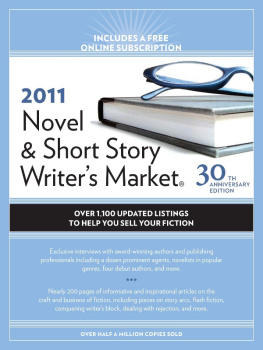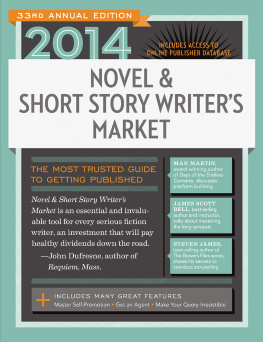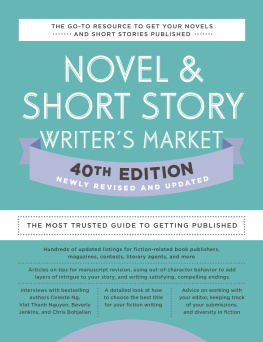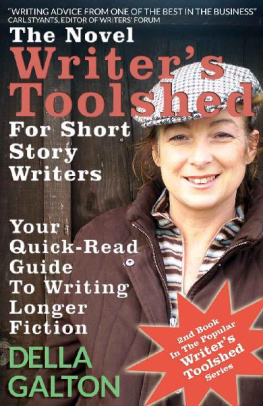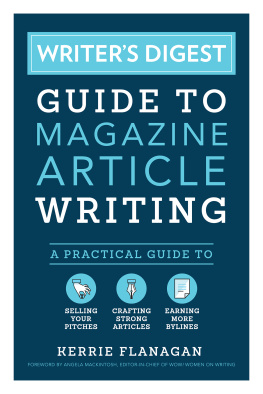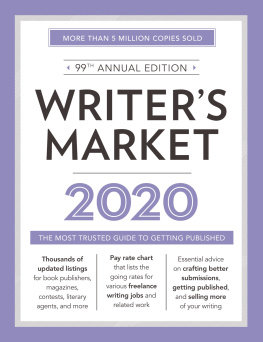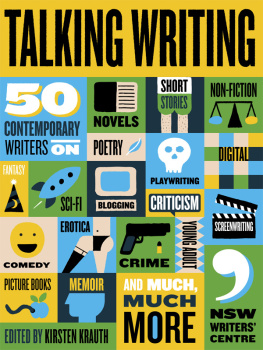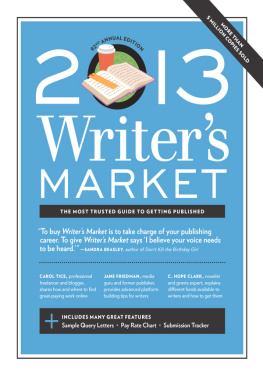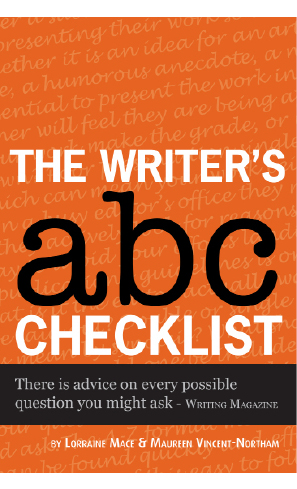Title Page
The Writers ABC Checklist
Lorraine Mace
and
Maureen Vincent-Northam
Publisher Information
Published by Accent Press Ltd
Digital Edition converted and published by Andrews UK Limited 2010
Copyright Lorraine Mace and Maureen Vincent-Northam 2010
Lorraine Mace and Maureen Vincent-Northam have asserted
their right to be identified as the authors of this work in accordance with the Copyright, Designs and
Patents Act 1988
All rights reserved. No part of this publication may be reproduced, stored in a retrieval system, or transmitted in any form or by any means, electronic, mechanical, photocopying or otherwise without the prior permission of the publisher: Accent Press Ltd, The Old School, Upper High Street, Bedlinog, Mid-Glamorgan CF46 6RY
Cover design by Red Dot Design
Dedication
Because writing is a lone occupation, requiring both sacrifice and understanding from family, we would like to thank our husbands.
To Chris, my husband and best friend, for his love and endless support.
Maureen
For Derek, with love and thanks for always being there my number one fan.
Lorraine
Acknowledgements
We would like to thank the many people who have asked us writing-related questions over the years. The inspiration for The Writers ABC Checklist came from each and every one of you.
We also wish to thank Accent Press for their belief in our book.
Preface
As most writers know, there is something extremely daunting about putting together a submission. Indeed, even established writers worry about presenting their work so that it makes the right impression. Whether it is an idea for an article, a short story for a magazine, a humorous anecdote, a novel or a non-fiction book, it is essential to present the work in such a way that the editors or publishers will feel they are being approached by a professional.
Will your work make the grade, or is your presentation letting you down? Poor presentation singles the writer out as an amateur, which can mean your work being rejected before it has been read. In a busy editors office they receive so many manuscripts that they actively look for reasons to reject work. So what is the best way to avoid your efforts landing in the instant rejection pile?
Asking for a publications guidelines is only the beginning of the process. What is it the editor actually wants? How should the manuscript be laid out? Double or single line spacing? What do the guidelines mean by synopsis? What should be in a covering letter and when should one be included? What is a title page? Whatever form your writing takes, this book provides the answers to all your questions, including those you didnt even know you should ask.
The A-Z format means the answers to specific questions can be found quickly and effortlessly. A quick glance through the index of this easy-to-follow guide shows where to go to learn the tricks of the trade which will get your work noticed for all the right reasons.
Where appropriate, the sections are carefully cross-referenced. This ensures that unfamiliar terms are explained. The references also point to the next logical step in the submission process. You can be happy in the knowledge that every angle has been covered and your submission will not declare you an amateur.
Bullet points are included at the end of most sections, providing a quick reminder of the main items covered.
This book will not teach you how to write (there are several excellent books on the market for that purpose and we have included a suggested list of further reading material). Our aim is to give you the best possible chance of seeing your writing published.
This is, quite simply, the ultimate guide to professional presentation. This unique book is packed with writing tips and is something no aspiring writer can afford to be without.
A
Abbreviations
See also: Capital Letters, Final Checks, House Style, Proofreading
Abbreviations are used all the time to shorten the names of organisations and technical terms so that theyre easier to remember. These are most often sets of initials, but what is the correct way to write them down?
There are a number of conventional rules for abbreviations and many publications have their own preference. But if this isnt immediately apparent to you, choose one of the accepted customs and stick to it throughout your work above all, be consistent.
Some abbreviations are so commonly used they need no further clarification: NHS, for example. But usually the longer name is used in full at the first mention, followed by the abbreviation in brackets: National Health Service (NHS). You need only write the abbreviation from then on. If you are using the name of an organisation only once in your article there is no need to supply an abbreviation for it.
When submitting to an overseas title, it is advisable to write out commonly used names in full when used for the first time.
If an abbreviation is unfamiliar, or looks awkward when written repeatedly, try using a generic word in its place such as the group, the corporation, or the organisation.
When writing with publication in mind, some commonly used abbreviations should be avoided and instead the full words substituted: use that is rather than i.e., use for example rather than e.g.
Abbreviations can be written using or omitting full stops, though it is becoming more usual in creative writing to leave them out. For example, most people use BBC rather than B.B.C. and UK rather than U.K. The same rule applies to names, Mr J T Smith now being more frequently used than Mr. J. T. Smith.
It is usual to include a full stop at the end of a contraction where the first letters are written and the rest of the word is omitted. For example, Rev. for Reverend or Prof. for Professor.
But where an abbreviation includes the last letter as well as the first, you do not take a full stop. For example, Dr for Doctor or Ltd for Limited.
Use only one full stop if your sentence ends with an abbreviation that already includes full stops.
When an original word is capitalised, the abbreviated word always retains its capital letter. For example, United Kingdom becomes UK. For words normally spelt with lower case letters, there is no hard and fast rule: POV or pov for point of view are both correct.
A lower case s, without an apostrophe, is added to an abbreviation to indicate a plural: TVs, CDs, MPs, and so on. And an apostrophe is not needed to indicate a shortened word when it has become a recognised word in its own right. So use phone not phone, use plane not plane.
To summarise:
Be consistent
Write full name followed by initials after first use
Write common names in full for overseas publications
Avoid abbreviations in creative writing
Accrediting Sources
See also: Acquiring Rights, Articles, Legal, Newspapers, Quotes, Research
The careful assembling of facts (see also Research) will lend authority to your work. To an editor it is an indication of the behind the scenes research undertaken by you in order to make your article or book as accurate as possible.
The editor will want to know the origin of your material, how reliable the facts are and whether they came from an authoritative source. Therefore, any data you may have gathered from another authors work or from an original document should be acknowledged.
Information judged to be common knowledge does not have to be accredited. Stating in your article that Antananarivo is the capital city of Madagascar would be considered common knowledge, even if you did need to look up the information. But you should accredit your source when citing a lesser-known fact about the country, or something which could be disputed the ratio of males to females, or the countrys most popular family pastime, for example. If you are in any doubt about something being common knowledge, always accredit your source.


